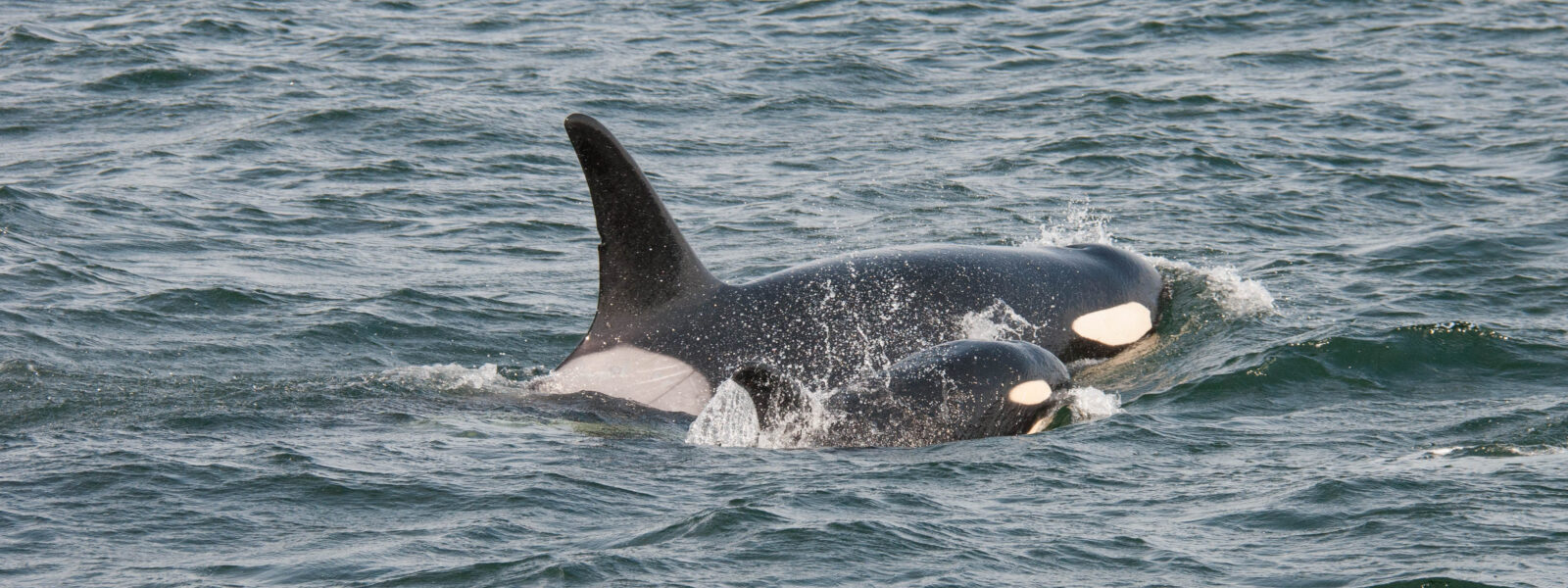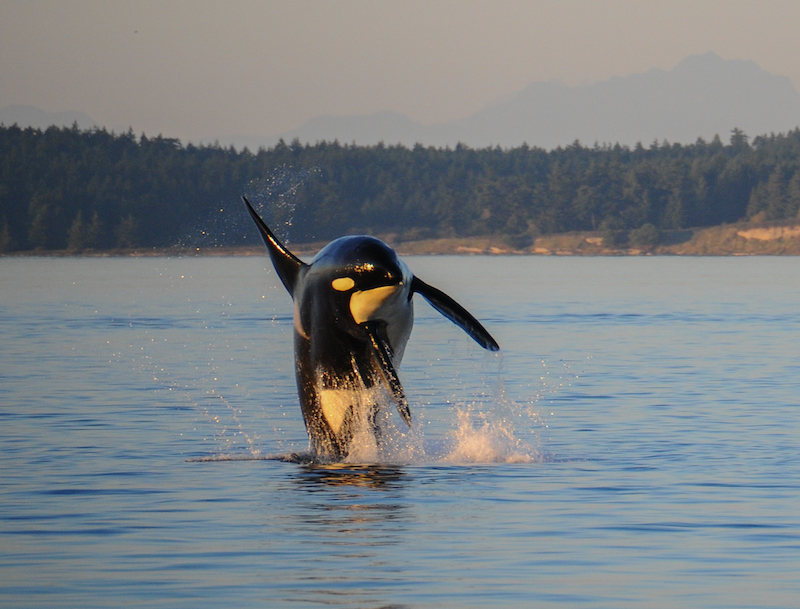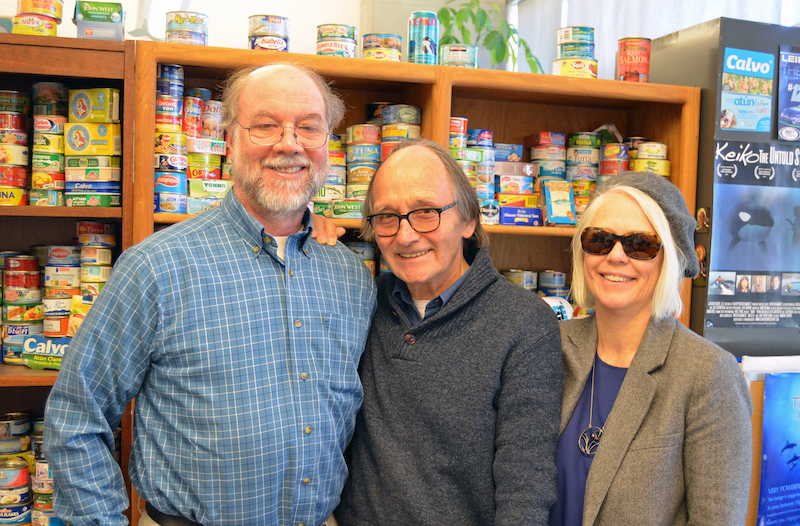
Give It Up For the Orcas
Dr. Paul Spong and Helena Symonds have studied wild orcas in British Columbia for more than 40 years. Paul and Helena have also played major global roles in promoting protection for cetaceans. Visit their website for more information.
(Above photo: Polaris J28 died at age 23, and her ten-month-old J54 died too.)
Make no mistake about it. Southern Resident orcas are facing a crisis. Yes, a crisis that could doom them to extinction within a couple of generations.
Extinction. It’s one of the ugliest words in our language. Most unfortunately, the word finds use so commonly as to be beyond comprehension in these desperate days for our precious planet.
The era we are living in is becoming known as the Anthropocene, the sixth great extinction of life on Earth, a time in which myriad unique species that had struggled to establish themselves and succeeded suddenly vanish. The word Anthropocene identifies the origin of their demise: Humans, us. Collectively and on a daily basis we are responsible for the extinction of species after species, many of which we probably didn’t even know existed.
Some we do know and know very well yet feel powerless in the face of their circumstances. Two among cetaceans spring to mind, the vaquita and the maui dolphin. Both species number less than 50, total. Their plight has aroused concern, outrage, and desperate attempts to salvage them, including, in the case of the vaquita, capturing and breeding a few, which failed and served only to make a bad situation worse.
Southern Resident orcas, universally admired for their grace, beauty and elegant lifestyle, along with the spectacular leaps and out-of-water antics that display their incredible energy, may not be a unique species, but they are a unique population formed in exquisite detail over the thousands of years that have passed since the last Ice Age ended. Unfortunately, the traits that make them so attractive to us led to the dark days of live captures in the ‘60s and ‘70s that did generational damage.
Today, they number just 74 individuals. They have not had a successful birth, meaning a baby who survived, in 3 years. The tragic spectacle of Tahlequah, a young orca mum, pushing her dead newborn baby ahead of her for 17 days and over 1,000 miles ignited worldwide concern which is a good thing but by no means enough.
The core problem for Southern Residents has long been identified as inadequate food. Resident orcas are fish eaters and focus on 2 species of salmon, Chinook or King, and Chum. Chinook salmon has been declining in numbers for decades and becoming physically smaller. They are the principle target, not just of orcas, but of sports fishers who are lured by photographs of fish as big or bigger than the person who caught them.
The government of Canada recognizes that the sports fishery poses a problem for orcas and this summer restricted fishing for Chinook salmon in some key areas frequented by orcas. In Washington State, sports fishers are obliged to catch and release wild spawned Chinooks but are allowed to keep hatchery-raised fish. These measures are helpful but woefully inadequate. Far better would be for all Chinook salmon to be dedicated solely to orcas; for all other catches to be banned, whether by sports commercial or First Nations fishers.
No doubt such a measure would cause hardship to some people and businesses, but the choice here is very clear. If we truly want the orcas to survive, everyone needs to give it up for the orcas! Our guess is that even trying this for 5 years will help stop or at least slow their relentless slide to extinction.
Other measures will help too, such as taking down dams on the Snake River system that are impeding salmon from spawning and serve little practical purpose, but that will take time. Giving all Chinooks to the orcas can be done with a stroke of a pen.
 Food is of course not the only issue, though it is the biggest one. Framed by three large cities, Seattle, Vancouver and Victoria, Southern Resident orcas live in one of the most heavily trafficked and polluted ocean environments on our planet. Victoria for decades has pumped raw sewage into the ocean and is only recently working to rectify this. Heavy shipping traffic from all 3 ports funnels through the Strait of Juan de Fuca, producing a cacophony of sound that interferes with orca communication and hunting.
Food is of course not the only issue, though it is the biggest one. Framed by three large cities, Seattle, Vancouver and Victoria, Southern Resident orcas live in one of the most heavily trafficked and polluted ocean environments on our planet. Victoria for decades has pumped raw sewage into the ocean and is only recently working to rectify this. Heavy shipping traffic from all 3 ports funnels through the Strait of Juan de Fuca, producing a cacophony of sound that interferes with orca communication and hunting.
Though measures like the Port of Vancouver’s experiment in reducing ship speed is potentially helpful, at the same time it is planning a radical increase in traffic by doubling the Roberts Bank coal terminal. Coal?! The word madness comes to mind. What are they thinking? Quite apart from the impacts on orcas, haven’t they heard of the climate crisis?
Then there is the plan being fiercely advocated and fought by Canada’s federal government to increase oil tanker traffic seven fold by tripling the pipeline that brings Tar Sands bitumen from Alberta to Vancouver. This will double the chances of a major oil spill, and if that happens nothing else will matter. Like Alaska’s AT1 pod who were decimated following the Exxon Valdez disaster and will likely soon cease to exist, Southern Resident orcas may become a page in a bleak history.
Two more issues, though not the end of the list, add to the burden orcas are bearing: space and viruses. By space we mean the space orcas need around them to go about their daily lives unencumbered by obstacles. The most common obstacles are vessels that approach them, often quite innocently, carrying people who want to enjoy their presence.
Whale watching has become so popular over the last few decades that it is now big business, and it is virtually unregulated. Anyone with a boat can get into the business, and though there are restrictions on approach distances there are no limits on numbers. As a result groups of orcas are often surrounded on all sides by vessels as they move about socializing and looking for a bite to eat. Many of the vessels are recreational boaters out for a fun day on the water, but others are commercial whale watchers on a schedule that takes them out to the orcas and back to their base for another load of passengers eager to catch a glimpse or better yet get a great photo of one of the most charismatic creatures on our planet.
There is nothing wrong with their desire or motivation, indeed whale watching is one of the salvations of whales long exploited by the whaling industry for their bodies alone. But it cries out for regulation. Licenses need to be issued, numbers of vessels controlled, time on scene limited, approach and departure speeds minimized to reduce acoustic impacts, and so on. It’s one of those situations that could be a win/win but is now mostly a win/lose for the orcas. The industry and boaters in general also need to give up some of the freedom they now enjoy, for the orcas!
So last we come to fish farms. Among the many problems they pose for the ocean environment – polluting, occupying prime sites for boaters etc. – they are spreading viruses that directly impact Chinook salmon red blood cells. The result is that Chinooks are weakened and die, directly depriving orcas one by one of a staple in their diet. There is hope here, as Washington State has decided to eliminate fish farms in its waters over the next 4 years, and, in British Columbia, First Nations are leading efforts to end open cage fish farming.
The end of the threat is by no means in sight, but the occupation of the fish farm at Swanson Island in the Broughton Archipelego near OrcaLab began a movement that addresses the threat and provides hope that normalcy to the ocean environment could be restored for the orcas and the salmon they rely on. We take note that Alaska has never allowed forests to be cut down to riverbanks, and it has never permitted fish farms; British Columbia allows both. Alaska, in sharp contrast to British Columbia, has recently enjoyed the biggest salmon runs in generations whereas those in British Columbia have been poor to non-existent. QED
Time will tell if good sense will prevail. In the meantime, think about this, which comes from biologist Alexandra Morton who has led the fight against fish farms:
If Southern Resident orcas become extinct, it will be the first extinction in which every individual name was known.
